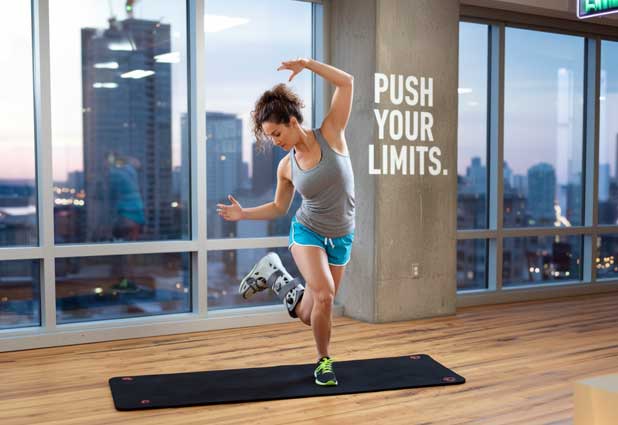Table of Contents
Introduction
If you are staring at your idle gym bag while balancing on crutches, you are not alone. After ankle surgery I spent eight weeks non-weight-bearing and was desperate to do anything besides sit. With my physical therapist’s help, I pieced together seated upper-body circuits, gentle core work, and tiny cardio intervals that respected my restrictions.
Everything in this guide assumes clearance from your doctor or physical therapist. Bring this plan to your next appointment and let them highlight what is safe, what needs to wait, and how to adapt movements to your specific injury.
Medical reminder
This guide is educational, not personalized medical advice. Only attempt exercises your doctor or physical therapist has approved for your specific injury, surgery, and weight-bearing status.
Key Takeaways
- Seated upper body work keeps arms, shoulders, and back strong with bands or light weights.
- Gentle core moves such as bracing and dead-bug arms reconnect your midline without standing.
- Provider-approved leg activation (quad sets, glute squeezes) maintain mind-muscle connection.
- Short blocks beat marathons. Two or three 10-minute sessions each week felt better than one long grind.
- Clearance is non-negotiable. Restrictions change weekly, so keep looping in your care team.
Safety Checks Before Any Workout
Confirm medical clearance. Ask your provider directly which movements, positions, or loads are off-limits. Restrictions can change each visit.
Know your weight-bearing status. Non-weight-bearing, toe-touch, or partial rules impact everything from transfers to leg positioning.
Set up a safe station. Use a stable chair or firm mat, clear clutter, and keep crutches within arm’s reach for transitions.
Check your energy and pain. Skip workouts on high-pain or dizzy days. Healing is still the main job.
Stop for red flags. Sharp pain, chest pressure, shortness of breath, or sudden swelling mean it is time to call your provider.
How I Tested Crutch-Friendly Exercise
I tested every setup I had at home. The bed was easy to access but too soft for core work. The couch worked for seated pressing, yet standing from it on one leg was sketchy. A kitchen chair became my go-to: firm, stable, and tall enough to transfer without loading my injured ankle.
A yoga mat on the floor gave me the best core surface, but I practiced safe transfers several times before adding any movements. I used bodyweight only at first, then added resistance bands and a pair of five-pound dumbbells once the motions felt natural.
To avoid fatigue, I started with 5-minute sessions and tracked notes in my phone: what felt energizing, what hurt, and how long recovery took. By week three I could handle 10–15 minute blocks twice per day without flaring symptoms.
Exercise Category Overview
- Seated upper body strength: band rows, chest presses, biceps curls, triceps work.
- Gentle core work: ab bracing, seated marches, dead-bug arm variations.
- Leg and glute activation: quad sets and glute squeezes only if cleared.
- Seated cardio: boxing intervals or fast-paced band circuits.
- Movement habits: safe transfers and daily tasks that double as mini workouts.
Seated Upper Body Exercises
Crutching already taxes your arms, but deliberate, controlled sets restore posture and balance out repetitive motions.
Seated band row
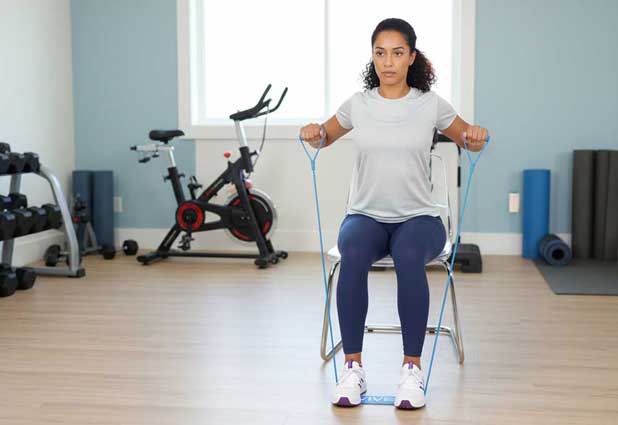
Sit tall with your injured leg elevated. Loop a resistance band around a sturdy anchor at chest height, hold both ends, and pull toward your ribs while squeezing your shoulder blades. Pause for a beat, then extend with control for 8–12 reps. This woke up my mid-back after hours of hunching over crutches.
Seated band chest press

Anchor a band behind your chair, hold the ends at chest level, and press forward without locking elbows. Return slowly for 10–15 reps. Adjust tension so the final reps feel challenging but smooth.
Seated biceps curls

With light dumbbells (or band handles), curl from your sides to your shoulders without swinging. Two sets of 10–12 reps kept my arms strong enough for everyday crutching.
Seated triceps extensions
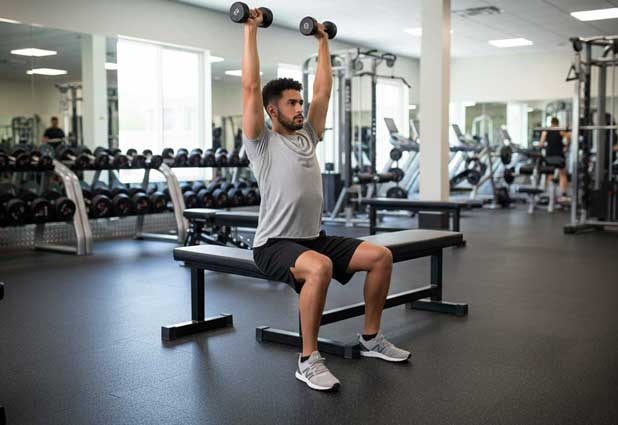
Hold one light weight overhead, bend at the elbows to lower behind your head, then press back up. I capped resistance at five pounds to avoid angry elbows already stressed from weight-bearing through my hands.
Hand & wrist backup
Extra upper-body work can aggravate sore palms. Pair these workouts with our hand and wrist comfort guide to keep grip pain in check.
Core Exercises Without Standing
Seated marches (if cleared)
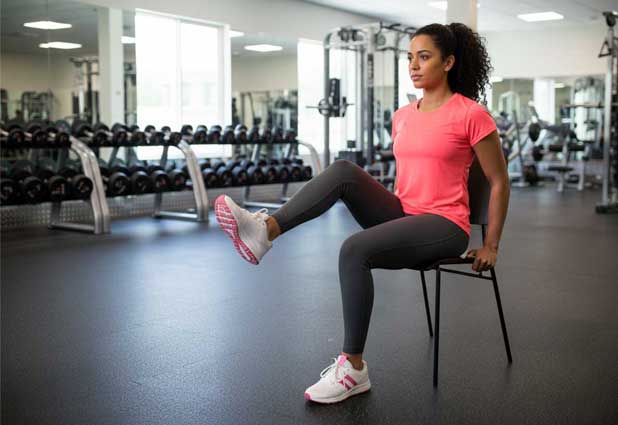
Sit on the edge of a chair, keep your torso tall, and lift your uninjured knee toward your chest while bracing your abs. If your provider allows hip motion on the injured side, gently lift that leg without letting the foot touch down. Alternate for 10–20 total raises.
Ab bracing with deep breathing
Lie on a firm surface with your injured leg supported. Inhale to let your belly rise, exhale while gently drawing your navel toward your spine, and hold that brace for five seconds. Repeat for 8–10 breaths. It sounds simple but reconnects sleepy core muscles.
Dead-bug arm reaches

On your back with one knee bent (uninjured side) and the other supported, reach one arm overhead while keeping your lower back glued to the mat. Alternate arms for 6–8 reps each to challenge stability without leg movement.
Leg and Glute Activation (Only with Approval)
Important
Do not attempt these moves unless your provider explicitly says they are safe. Leg activation too soon can derail recovery.
Isometric quad sets
Lie down with both legs supported, tighten the muscle on top of your thigh, and gently press the back of your knee toward the surface for five seconds. Start with the uninjured side, then progress to the injured side only when cleared. Ten reps per session helped me feel connected to my immobilized leg again.
Glute squeezes
Sitting or lying down, squeeze both glutes together for five seconds and release. Repeat 10–15 times. It is low effort but keeps those muscles awake while you are grounded.
Seated Cardio Options
Seated boxing
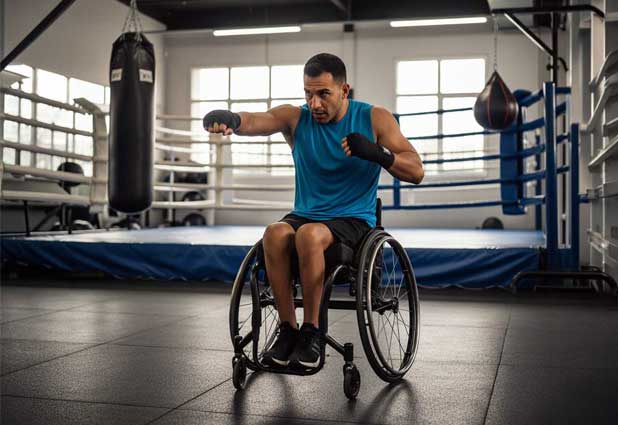
Sit tall, keep your injured leg elevated, and throw fast but controlled punches in the air for 30 seconds. Rest 30 seconds and repeat four to six rounds. My heart rate climbed into the 110s without leaving the chair.
Fast-paced band circuit
Rotate through 15 band rows, 15 chest presses, 12 curls, and 12 triceps press-downs with minimal rest. Complete two or three rounds to turn strength into cardio.
Sample Weekly Plan
This structure kept me active without overwhelming recovery. Swap days or volume as energy allows.
| Day | Focus | Example moves | Minutes |
|---|---|---|---|
| Monday | Upper body strength | Band rows, chest press, curls | 10–15 |
| Tuesday | Gentle core | Ab bracing, seated marches | 8–10 |
| Wednesday | Seated cardio | Boxing or fast band circuit | 12–15 |
| Thursday | Rest / light movement | Glute squeezes, stretching | 5 |
| Friday | Upper body strength | Rows, triceps, shoulder work | 10–15 |
| Saturday | Core + light cardio | Dead-bug arms, boxing | 10–12 |
| Sunday | Full rest | Normal ADLs only | 0 |
Notes: I began with only Monday, Wednesday, Friday workouts and added Saturday in week four. Missed days simply slid to the next available slot.
Everyday Tasks Still Count
Crutching around the house is a workout. Between bathroom runs, kitchen trips, and seated chores, I clocked 2,000–3,000 “steps” per day. Seated dish washing, folding laundry on the bed, and rearranging shelves all doubled as mini exercise snacks as long as I respected my restrictions.
Carrying objects safely also increases daily movement. If you have not already, read our carrying guide for backpacks, crossbody setups, and container hacks.
Fast pre-workout checks
- Provider has cleared today’s exercises.
- Weight-bearing rules still prohibit loading the injured side.
- Chair or mat is stable, pathway is clear.
- Pain level is manageable and swelling is baseline.
- Water bottle and phone within reach.
When to Change Devices or Plans
If crutches alone exhaust you, ask your provider about mixing in a knee scooter or wheelchair for longer distances. Saving upper-body energy for purposeful exercise beats burning it all on commutes. Our knee scooter reviews and premium crutch breakdown can help you compare upgrades.
Likewise, if scheduled workouts leave you wiped for days, scale back. Recovery is still job one, and exercise is there to support it—not compete with healing.
Common Mistakes
- Skipping clearance. I tried a full circuit on day three and my PT nearly revoked my bands.
- Accidentally loading the injured leg. Transfers on and off the floor were the biggest culprits until I practiced them slowly.
- Comparing to pre-injury numbers. Crutch life is not the moment to chase PRs.
- Ignoring pain signals. Sharp shoulder pain after boxing meant I needed lighter punches.
- Skipping rest days. Feeling “idle” made me want to overcompensate. Rest actually sped up my healing.
Exercise Snapshot
| Area | Example | Equipment | Frequency | Notes |
|---|---|---|---|---|
| Upper body | Seated band row | Resistance band | 2–3x weekly | Great for posture |
| Upper body | Band chest press | Resistance band | 2–3x weekly | Works chest & shoulders |
| Core | Ab bracing | Bodyweight | Daily | Gentle activation |
| Core | Seated marches | Bodyweight | 2–3x weekly | Only if hip motion cleared |
| Leg activation | Quad sets | Bodyweight | Daily if cleared | Keep holds short at first |
| Leg activation | Glute squeezes | Bodyweight | Daily | Most injuries allow early |
| Cardio | Seated boxing | Bodyweight or 1 lb weights | 2–3x weekly | Intervals of 30s on/off |
| Cardio | Fast band circuit | Resistance band | 1–2x weekly | Combines strength & cardio |
FAQ: Exercising on Crutches
Yes, but only after your doctor or physical therapist clears specific movements. Most people can do seated upper-body and gentle core work, yet every injury is different, so get personalized parameters first.
Stick to seated or lying exercises that keep all weight off the injured side: band rows, chest presses, ab bracing, dead-bug arm reaches, and PT-approved isometrics such as quad sets.
Begin with two or three 5–10 minute sessions per week. Increase only when pain, swelling, and fatigue stay low for several days in a row.
They maintain strength and cardio capacity so you are not starting from zero once cleared for weight-bearing. Some deconditioning is unavoidable, but these sessions shorten the comeback.
Stop immediately if you feel sharp pain, dizziness, shortness of breath, swelling, warmth, or any concerning symptom. When in doubt, contact your provider.
Final Thoughts
Staying in shape on crutches is not about chasing PRs. It is about protecting your strength, mobility, and confidence so returning to “normal” feels less daunting. Bring this plan to your provider, start with one or two approved moves, and increase only when your body says it is ready.
Pair these workouts with the rest of our crutch guides—carry strategies, hand comfort tips, and mobility comparisons—to build a recovery routine that feels possible, not punishing.
Related Guides
Keep your routine rounded out with these favorites:
